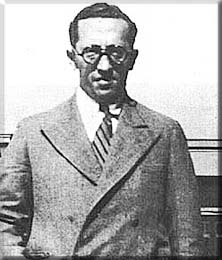bringing weapons and refugees to Israel. Some of the weapons were to
be turned over to the Haganah and others to be kept by the Revisionists fighting the Arab invading armies. Whether deliberately, or
by a series of errors, the weapons and the ship were not surrendered to the Haganah. The refugees were landed in Israel. The ship,
an LST, a landing craft designed to be beached and off-loaded, was sailed to the center of Tel Aviv and grounded in full public view.
Ben Gurion ordered the ship and the defiant Revisionist fighters on board destroyed. Deadly Jewish canon fire was directed against
the Jewish ship. Haganah small arms fire killed Jews attempting to swim to safety. In the conflagration, amidst exploding
ordinance, Avraham Stavsky helped Menachem Begin get to shore. Begin could not swim. Stavsky was killed by Jewish fire.
The commander of the Haganah, directing the destruction of the Altalena and its Revisionist crew, was Yitzhak
Rabin27. Prime Minister Yitzhak Rabin was assassinated by Yigal
Amir, November 5, 1995. 28
Who murdered Arlosorff? The answer depends on who is telling the story and for what purpose.
Jerry Klinger is president of the Jewish American Society for Historic Preservation
www.Jashp.org
1
In 1929, the Jewish Agency for Palestine was officially created by the 16th Zionist Congress, held in Zurich. The new
body was larger and included a number of Jewish non-Zionist individuals and organizations, who were interested in Jewish settlement
in Palestine.
2
Mapai (Hebrew: ", an acronym for Mifleget Poalei Eretz
Yisrael (Hebrew:
), lit. Workers' Party of Eretz Yisrael) was a left-wing political party in Israel, and was
the dominant force in Israeli politics until its merger into the Israeli Labor Party in 1968.The party was founded on 5 January 1930 by the merger of the Hapoel Hatzair founded by A. D. Gordon and the original Ahdut HaAvoda (founded in 1919 from the right,
more moderate, wing of the Marxist Zionist socialist Russian party Poale Zion led by David
Ben-Gurion). In the early 1920s the Labor
Zionist movement had founded the Histadrut Union,
which dominated the Hebrew settlement economy and infrastructure, later making Mapai the dominant political faction in Zionist
politics. It was also responsible for the founding of Hashomer and Haganah, the first two
armed Jewish groups who secured the people and property of the new and emerging Jewish communities. By the early 1930s, David Ben-
Gurion had taken over the party, and had become de-facto leader of the Jewish community in Palestine (known as the Yishuv).
3
http://en.wikipedia.org/wiki/Haavara_Agreement
4
http://www.zionism-israel.com/dic/Yishuv.htm
5
http://wikibin.org/articles/assassinations-of-jewish-leaders-relating-to-israel-and-
zionism.html
6
http://en.wikipedia.org/wiki/Uganda_Proposal
7
http://en.wikipedia.org/wiki/Haganah
8
http://en.wikipedia.org/wiki/Jabotinsky
9
http://en.wikipedia.org/wiki/David_Ben_Gurion
10
http://en.wikipedia.org/wiki/Revisionist_zionism
11
http://en.wikipedia.org/wiki/Chaim_Weizmann
12
http://www.zionism-israel.com/bio/Chaim_Weizmann_biography.htm
13
http://www.jewishvirtuallibrary.org/jsource/judaica/ejud_0002_0020_0_20251.html
14
http://jewishmag.com/148mag/jewish_legion/jewish_legion.htm
15
http://en.wikipedia.org/wiki/Haavara_agreement
16
Magda Goebbels by Anja Klabunde, Little Brown, 2001 (Time Warner Books U.K. ) pg. 186-
187
17
Ibid. pg. 188
18
Ibid. pg. 189
19
Ibid. pg. 191
20
Ibid pgs 191-192
21
Ibid. Pgs. 193-199
22
Ibid. Pg. 200
23
The Seven Lives of Colonel Patterson, Denis Brian Syracuse University Press New York 2008 pgs. 169-
171
24
http://en.wikipedia.org/wiki/Abraham_Stavsky
25
Ibid. pg. 171-175
26
http://en.wikipedia.org/wiki/Altalena_Affair
27
http://en.wikipedia.org/wiki/Assassination_of_Yitzhak_Rabin http://en.wikipedia.org/wiki/Yitzhak_Rabin
28
http://en.wikipedia.org/wiki/Yigal_Amir
~~~~~~~
from the December 2010 Edition of the Jewish Magazine
